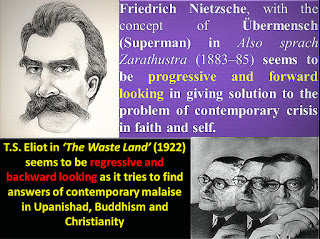Thinking Activity The Waste Land Poem
* About The Waste Land poem:-
The waste land is a poem by T.S.Eliot widely regarded as one of the most inportant poems of the 20th century and a central work of modernist poetry.it was published in book from in December 1922. Among its famous phrases are
"April is the Cruellest month",
"I will show you fear in a hand full of dust", and the mantra in the Sanskrit language "Shantih Shantih Shantih". this epic poem divided into five parts Different as,
(1) The Burial of the Dead
(2) A game of chess
(3) The Fire Sarmon
(4) Death by Water
(5) What the thunder said
This poem is a very long but interesting poem by writing T.S.Eliot. this poem also represented the sexual perversion and spiritual degradation.
Q-1) What are your views on the following image after reading 'the waste land'? do you think that Eliot is regressive as compared to Nietzsche's views? or has Eliot achieved universality of though by recalling mythohistorical answer to the contemporary malaise ?
ANS:- This question in my point of view I think Frederic Nietsche was a German philosopher. he been some people came out with strong will power and more mental ability, enthusiasm. the mythical views like Upnishada login. supernatural power and various cultures Eliot to evoke the past is very good lesson to make better Future. the Eliot gave example for like Upanishad, Buddhism and Christianity. he was also symbol like red rock symbolize Christianity. Third part of poem in the Buddhism and last part Upanishad by Eliot. he was hanged man means Jesus Christ. we found that people who are involved in sexual perversion.
Q-2) Prior to the speech, Gustaf hellstrom of the Swedish academy made these remarks:
What are your views regarding these comments? it is true that giving free vent to the repressed 'primitive instinct' lead us to happy and satisfied life? or do you agree with Eliot's view that salvation of man lies in the preservation of the cultural tradition?
ANS :- This question in my point of view is a the disorganization in community and word. this poem is sexual perversion and spiritual degeneration also he "life in death and death in life" the cycle of life by Freud the profound cause of lay in unbehagen cultural modern man. he mentioned about modern man or we can say that waste modern epic.
Q-3) Write about allusions to the Indian thoughts in "The Waste Land".( Where how and why are the Indian thoughts referred?)
ANS:- My point of view this poem was combination and vivid languages myths. the last part of the waste land poem that Eliot use the example from Indian concept in the fifth part of the poem.
1) Buddha's sermon :-
The Waste Land third part the one idea of fire sermon and Buddha sermon.
2) River Ganga and Himalaya :-
" Ganga was sunken, and the limp leaves
Waited for rain,while the black clouds
Gathered far distant, over Himavat".
Ganga is a purification Himalaya is a spirituality and peace.
3) Three Da :-
Datta... (Devote)
Dayadhavam... (Sympathize)
Damyata...(Control)
Da... Da... Da... reminder to practice self control.
4) Thunder :-
"The jungle crouched,humped in silence
Then spoke the thunder.
This poem use thunder from Upanisad vedas. there is reference of Upanisad in Prajapati. thunder aakashvani to devotes are pointed of salvation.
5) Santih Santih Santih Mantra :-
This line is a the Waste land poem last line about ultimate peace every human being craving. this can be considered as universal human.
THANK YOU



No comments:
Post a Comment